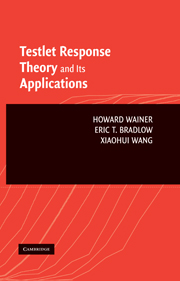Book contents
- Frontmatter
- Contents
- Preface
- PART I INTRODUCTION TO TESTLETS
- 1 Introduction
- 2 True score theory
- 3 Item response theory
- 4 What's a testlet and why do we need them?
- 5 The origins of testlet response theory – three alternatives
- 6 Fitting testlets with polytomous IRT models
- PART II BAYESIAN TESTLET RESPONSE THEORY
- PART III TWO APPLICATIONS AND A TUTORIAL
- Glossary of terms
- Epilogue
- Bibliography
- Author Index
- Subject Index
2 - True score theory
Published online by Cambridge University Press: 08 January 2010
- Frontmatter
- Contents
- Preface
- PART I INTRODUCTION TO TESTLETS
- 1 Introduction
- 2 True score theory
- 3 Item response theory
- 4 What's a testlet and why do we need them?
- 5 The origins of testlet response theory – three alternatives
- 6 Fitting testlets with polytomous IRT models
- PART II BAYESIAN TESTLET RESPONSE THEORY
- PART III TWO APPLICATIONS AND A TUTORIAL
- Glossary of terms
- Epilogue
- Bibliography
- Author Index
- Subject Index
Summary
God created the integers. All else is the work of man.
Leopold Kronecker (1823–1891)Historically, methods for scoring tests grew from basic notions of having experts evaluate the responses to the questions and assign a score. When possible, precautions were taken to ensure that the judges, to the extent possible, were not biased in their judgments because of other knowledge they had about the examinee. In ancient China, written answers were sometimes rewritten by a professional scribe to ensure that the examinee's identity was hidden. As the structure of tests changed to include a large number of questions, the scoring methods were modified apace. Typically, each question was assigned a certain number of points and an examinee's score was determined by adding together the number of points associated with the questions that were responded to correctly. This notion underlay test scoring for most of its four-thousand-year history. It was formally codified within the last century with the development of what has come to be called “true score theory.”
Why do we need a theory for test scoring? The fundamental idea of a test, once ingested, seems simple. Count up the points and whoever has the most wins. And, indeed when tests are used as contests, this may be enough. But as we pointed out in Chapter 1, this is not the only use of a test. Tests as prods don't need much theory either, but tests as measuring instruments do. Because using a test as a measuring instrument is a relatively new application, it is not surprising that a formal theory of tests did not begin to appear until the 20th century.
- Type
- Chapter
- Information
- Testlet Response Theory and Its Applications , pp. 14 - 23Publisher: Cambridge University PressPrint publication year: 2007
- 2
- Cited by



